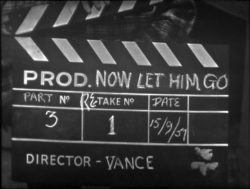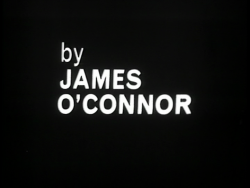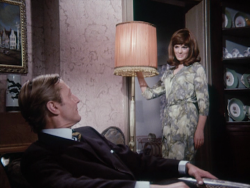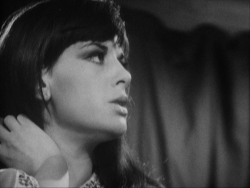by OLIVER WAKE
Thirty-Minute Theatre Writer: Friedrich Dürrenmatt; Translated by: Robert David MacDonald; Producer: Innes Lloyd; Director: Rudolph Cartier
Thirty-Minute Theatre was a drama strand instigated by the BBC to return shorter plays, transmitted live, to the television schedules.1 It began in October 1965 with a version of Roald Dahl’s Parson’s Pleasure, and ultimately produced over 250 dramas, although by the end of 1968 the live element was had been entirely dropped. 1969’s Conversation at Night was director Rudolph Cartier’s fourth entry into the BBC2 anthology, following Brainscrew in 1966, The News-Benders in 1968, and the Hitler segment of the These Men Are Dangerous trilogy from earlier in 1969.2 It was Cartier’s last production under BBC contract as he returned to freelance work thereafter.3
The short play was written by leading post-war Swiss dramatist Friedrich Dürrenmatt, who is best known for his full-length satirical stage dramas The Visit and The Physicists. Conversation at Night started out as a German radio play in 1952 and transferred to the Munich stage the same year. It came to Britain as a radio play first, translated and produced by Christopher Holme for the BBC’s Third Programme in 1963.4 The stage version premiered in London in 1966. For television, the play was translated by Robert David MacDonald and produced by Innes Lloyd.
The play is a duologue between a prominent liberal writer in an unnamed European dictatorship and the state assassin. Confronted in his own study, the writer attempts to defend his freedom of expression in the face of the assassin’s advocacy of the status quo. The play is more than a Platonic dialogue however, also discussing “what the executioner calls ‘the art of dying’, of accepting death without rebellion, bitterness or terror”, as The Times reported, with the writer ultimately able to accept his demise with a quiet dignity.5


 James O’Connor – often known as Jimmy O’Connor – wrote a number of popular and successful television plays in the 1960s and early ‘70s, regularly collaborating with director Ken Loach. He had an unusual background for a television dramatist. He was formerly a career criminal who had turned to writing while serving a life sentence for murder, having narrowly avoided being hanged.
James O’Connor – often known as Jimmy O’Connor – wrote a number of popular and successful television plays in the 1960s and early ‘70s, regularly collaborating with director Ken Loach. He had an unusual background for a television dramatist. He was formerly a career criminal who had turned to writing while serving a life sentence for murder, having narrowly avoided being hanged.  How and why is George’s Room in colour? Anyone coming to George’s Room knowing the rest of director Alan Clarke’s plays for Rediffusion’s Half-Hour Story strand thanks to the BFI’s Alan Clarke at the BBC set might wonder why this is the only one in colour and why it looks so different from the others.
How and why is George’s Room in colour? Anyone coming to George’s Room knowing the rest of director Alan Clarke’s plays for Rediffusion’s Half-Hour Story strand thanks to the BFI’s Alan Clarke at the BBC set might wonder why this is the only one in colour and why it looks so different from the others. The BFI’s superb new Alan Clarke box sets contain many treats – they at last make most of the director’s surviving BBC work available to everyone and do so with such loving remastering and restoration that even those of us who have seen these pieces many times have never seen or heard them like this – but I’m particularly pleased with the bonus DVD on the main blu ray set
The BFI’s superb new Alan Clarke box sets contain many treats – they at last make most of the director’s surviving BBC work available to everyone and do so with such loving remastering and restoration that even those of us who have seen these pieces many times have never seen or heard them like this – but I’m particularly pleased with the bonus DVD on the main blu ray set